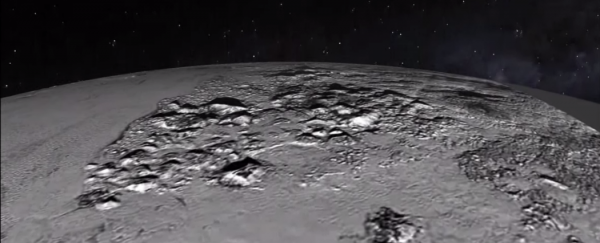
Last Friday, NASA's New Horizons spacecraft delivered the most detailed view ever of Pluto's stunning heart-shaped region. Named the Tombaugh Regio (Tombaugh Region), after Clyde Tombaugh, the American astronomer who discovered Pluto back in 1930, we can now see the icy Norgay Montes (Norgay Mountains) and Sputnik Planum (Sputnik Plain) that make up a portion of this 1,600-km-long region in the simulated flyby video above.
The animation was put together using images recorded by New Horizons during its closest approach on 14 July. Captured by the onboard Long Range Reconnaissance Imager (LORRI) from a distance of 77,000 km (48,000 miles) away, the images allow scientists to view and analyse surface features as small as 1 km across. The information imparted by these images reveals that Pluto's mountains are not only much younger than expected - they are some of the youngest surfaces ever found in the Solar System. "The Solar System definitely saved the best for last," principal investigator Alan Stern told the media as the animation was released.
These strange mountains jut 3,500 metres above the surface, and according to NASA, formed no more than 100 million years ago. Which sounds like a whole lot of years, but it's nothing compared to the 4.56-billion-year-old Solar System. This suggests that Pluto isn't just a stagnant hunk of icy rock - it could still harbour some unexpected geologic activity beneath the surface that gave rise to these curious features. And no one's quite sure what could be causing these just yet. "This may cause us to rethink what powers geological activity on many other icy worlds," New Horizons Geology, Geophysics and Imaging Team (GGI) deputy team leader, John Spencer, said in a press release.
"This terrain is not easy to explain," Jeff Moore, the GGI project leader, added. "The discovery of vast, craterless, very young plains on Pluto exceeds all pre-flyby expectations."
Perhaps the surface materials are cracking and drying, and that's how these mountains formed, the team suggests, or they could be the result of frozen carbon monoxide, methane, and nitrogen reacting with each other beneath the surface to cause the process of convection, which makes everything bubble up on the surface.
One mountain-making possibility the team has been able to discount is the process of tidal heating. As Amy Thompson points out at Ars Technica, the largest cosmic body nearby to Pluto is its moon Charon, and since it is tidally locked with Charon, there's not a lot of heat exchange between them. "Whatever provides the power, it could reshape the surface through possibilities that include geysers and or cryovolcanoes," she says. "Neither of these processes has been observed yet, but the team will be looking for evidence of them."
New Horizons truly is the gift that keeps on giving. Check out this awesome gallery of images and animations it's delivered so far as we wait to see what it dishes up next.
